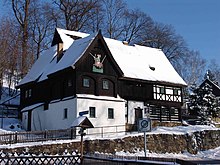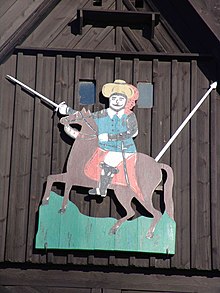Riding house
The rider's house is a monument and local history museum on Bundesstraße 96 in Neusalza-Spremberg , which was built before 1660 as a small farmhouse in a surrounding construction and supplemented with the west wing (also known as the rider wing) before 1800. It is one of the oldest and most picturesque half timbered houses in the Upper Lusatia area . The house owes its name to the colorful wooden equestrian figure on the gable of the west wing.
history
Around 1660 the house was built for a small farmer. The city's most famous son, Johann George Schreiber, was born near the historic building in 1676. In 1720 there was a notarized change of ownership of the riding house. Around 1760, the surrounding area of the block room on the gable and the street-side eaves side was rebuilt. Before 1800 the west side extension took place, possibly as a double enclosure, but probably with masonry on the ground floor and surrounding structure on the upper floor. In 1847 another renovation takes place without further details.
In 1874 the wooden equestrian figure was attached to the gable of the west wing. This brought the 20-year-old house daughter (Christiane Louise Schniebs) home as a prize from a knight stinging in Lauba , a widespread fun fair among female youth at that time.
In 1928 the city council proposed to secure the building, which was valuable in terms of building history. As early as 1938, the building was included in the state monument list as an “art and cultural monument”. The city acquired the riding house in 1939 after laborious negotiations from the community of heirs and arranged for a new roofing with straw in the same year. In the years 1944 to 1954 the house was inhabited by several families as emergency quarters, and a chimney conversion was necessary in the main house. In the following years the apartment in the west wing will be renovated, the block room part will be renewed and the retaining wall will be built on the slope behind the building. After complete restoration from 1961 to 1963, the riding house was again used for residential purposes, while a local history museum was set up in the main building. In 1993 the block room in the main house was renovated and in 1997 the building was re-covered with thatch .
museum
In the museum, the special construction method is presented in detail in writing and images, as well as reports on the everyday life of small farmers, house weavers and craftsmen in the 19th century in Upper Lusatia. Original furnishings and tools are exhibited in several rooms, including the example of a living room and weaver's room with tools for typical home weaving in the region (e.g. a hand loom ), a shoemaker's room , a bedroom and a hallway. Special exhibitions by artists, collectors and photographers from the region are shown in two rooms in the west wing.
literature
- Theodor Schütze (Ed.): Between Strohmberg, Czorneboh and Kottmar (= values of our homeland . Volume 24). 1st edition. Akademie Verlag, Berlin 1974.
- Gunther Leupolt : The history of the riding house in Neusalza-Spremberg. In: History and stories from Neusalza-Spremberg. Volume 1. Ed .: Kultur- und Heimatfreunde Neusalza-Spremberg e. V. Neusalza-Spremberg: Michael Voigt 1999, pp. 28-34
- Gunther Leupolt: Meaning and history of the knight image at the riding house. In: Ebda, pp. 35-37
Web links
Coordinates: 51 ° 2 ′ 15 " N , 14 ° 32 ′ 29.7" E

